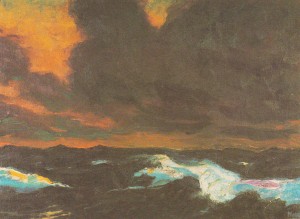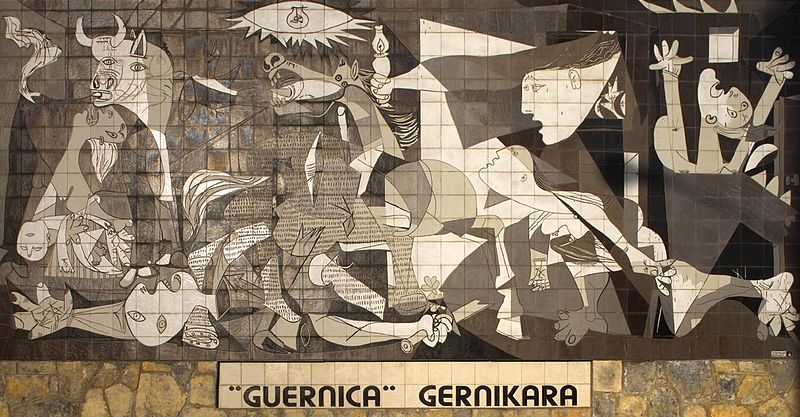 The Die Brucke group of Painters.
The Die Brucke group of Painters.
In a working class area of Dresden, Germany in 1905, a group of ex-architecture students got together to form a community of painters, rather in the way that the Guilds of The Middle Ages operated. Members of the group were Heckel, Kirchner, Pechstein, Schmidt-Rottluuf and for a short time Emil Nolde.
Emil Nolde 1867-1956, soon left the group to go travelling around Europe, he preferred solitude to work on his paintings, they show an integrated vision of the world, that celebrated a love of nature and all that was around him?
In 1930 he painted a series of paintings which he named The Sea. He worked on the island of Sylt, Germany. He wrote, ‘I had a wish to live and paint as alone as possible, only observing and in particular, I wanted to see the sea again, in all it’s wild greatness. His work portrays a savage wildness.
I love to paint the sea, aware of its constant ebb and flow, with huge skies that tower above, often filled with ever changing cloud patterns.
These painters have influenced future paintings in many ways, for example Expressionist painters in the 20th.century, such as Edvard Munch, who painted The Scream and The Sick Child. He wrote ‘there must be living beings painted, who breathe and feel and love and suffer’. His work displays these emotions. Violent distortion and execution of colour were used to express deep or violent emotions – not simply painting what the eye can see.
I wonder if these paintings absorb such emotions, neutralise them? Robert Ellis writes: ‘integration needs to be described in terms of psychological states, rather than just in terms of philosophical analysis of meaning’.
I would welcome your views please.
All posts by Norma Smith
Embodied Meaning in a painting.
Guernica 1937. Picasso.
In the 1930s,, Franco in Spain was waging war against Spanish civilians. With help from Hitler, he chose to bomb the Basque town of Guernica. To quote Picasso ‘ The war in Spain is the battle of reaction against the people, against liberty.’
Picasso had a horror of the military caste, which plunged Spain into a sea of suffering and death. He was making a political stand when he worked on Guernica. He portrayed a mirror-image of a world of atrocity and bestiality – ‘ from which it is man’s duty to emerge.’
The symbols he uses are powerful, the noble horse is struck down, the bull represents a brutal force of darkness. Faces were distorted with pain, light comes from an electric light bulb, not the sun, there is no divine power to relieve them. As work progressed, photographs were taken of each stage, to reveal Picasso’s thinking processes.
In order to understand Picasso, it helps to ‘grasp his idea and hold it.’ It is an historical painting, painted to remember their own history. We are asked to accept Picasso’s idea and images, or we cannot understand his work.
Picasso was aware of the poem by Eluard,
La Victoire de Guernica. 1936:-
Watch the builders at work
They are rich, patient, disciplined, black and stupid
But they do their best to be the only ones on earth
They are on the edges of humanity and heap it over with ordure
They flatten mindless palaces to ground level.
I think of Ground Zero.
Picasso also wrote a poem called The Dream and Lie of Franco.

BBC Reith Lectures 2013, given by Grayson Perry. Playing to the Gallery.
The Final State of Art.
I listened to the third talk in the series today. Grayson Perry first discussed the relationship between Society and Art and how some artists are under the impression that the role of the artist is to shock, he suggested that there is nothing new in this approach, we can think of Duchamp’s work or that of the Fauve artists, who were called the Wild Beasts. He think that many of us seem to looking for rebellion in art, he gave a humorous description of ‘maya’, as being the most advanced yet acceptable! In other words, outrage has become domesticated, ‘gentrification is under way! I think that his humorous approach to the subject, succeeded in involving himself with the enthusiastic audience, it was liberally sprinkled with facetious quips. The fact that he has become part of the Art Establishment he finds amusing, potters at one time were perceived as ‘folksy’ and not serious artists.
He talked about manifestos, can anything be called art as long as it has a manifesto, in which the purpose of the piece is set out? He will always want to encourage artists, while also mentioning that not everything in his opinion, can be called Art.
Many ‘isms’ were listed, pluralism, commercialism, globalism, nepotism and capitalism.
Globalism is inevitable, is art produced for commercial gain really genuine? Art produced without that motivation may become popular, maybe it is beautiful, then the artist will earn his or her keep. It is hard for young artists to earn enough to afford studio rents and many artists gather in low priced housing areas, Grayson Perry warned that these areas can become trendy places to visit!! The Bobos are bourgeois bohemians, I think named so by D. Brooks in one of his books. Tracy Emin was mentioned, the Tory voter, said with feeling, that made me smile. He knows how to create some degree of shock too and relishes it I think.
I hope that some of you heard the talk and would like to add a comment.
Quotes and thoughts on the embodied mind, with painters in mind!
Over recent decades, a great deal of new research has been done on the brain and how it functions. ‘The embodied mind emphasises that the body helps to shape the way we think, feel and behave, it is an embodied and relational process, that regulates energy and information flow.’ With the Cartesian paradigm -body and mind – ‘we have logical, linear, sequential meaning,’ but this leaves out ’emotions, intuition, creativity and a capacity to dare to try different solutions.’ In the Cartesin paradigm, ‘Taking advantage of the benefits brought about by the right hemisphere of the brain, such as creative imagination, serenity, a global view and a capacity of synthesis are not considered. In Antonio Damasio’s book,’Descarte’s Mistake’ he writes ‘the vision of the human being as a whole, is the key to the global development of the being.’
Meaning comes out of experience.
The writer, James Joyce wrote, ‘Our creativity has propelled human evolution.’
Classical styles of Chinese landscapes developed from the desire to leave the problems of society behind and look towards Nature, ‘men sought permanence within the natural world, it showed the inner landscape of the artist’s heart and mind.’
Impressionist painters, such as Claude Monet, worked outdoors and rapidly, in order to catch the fleeting sun light on the scenes they painted. Art critics at the time, scorned their work, but these painters were ‘in the moment’ when they painted.
Paul Cezanne (1839 – 1906) wrote, ‘The landscape thinks itself in me and I am in its (the landscape). He also had a great respect for Nature, he would look at a mountain, for example, seeing the changing light as he worked, building up the scene in geometric shapes. In his still life paintings of apples, he used soft colours, with certain areas highlighted by stronger colour in small patches. ‘An artist builds up an internal tension of some kind, then comes a need to start work.’ Cezanne called it his ‘petit sensation’ he saw it as a secret key to art, an intimate and private experience. ‘It is like an internal energy or ’emotion’ that needs to be used, ‘it brings about an emotional relationship with the art when it is completed.’ I have painted canvases which result in the same experience, I look at the painting and can relive the feeling I had when I painted it, always remembering of course, that memories are constantly revised.
Some aesthetic quality, such as balance and harmony is required, otherwise it is ‘an expression of mess’ another quote I picked up on!
Howard Hodgkin, whose works are not among my favourites, but I know someone who finds them meaningful,
writes, ‘art has the capacity to recreate a strong effective charge within certain colours and shapes, a way in which his, the artist’s memories, are recovered. Colour, texture and line are ways the painter makes his/her marks. I like to work with colour most of all. He also said ‘we come to a place when we get back something from the painting’ and then the painting may give back a similar experience to the viewer.
Paul Klee took a line for a walk, a wonderful way to express creativity, not a doodle, because his line drawings are simple yet beautiful.
I would recommend that it’s better to look at a painting for a while, before reading about the painter’s life or the message he or she is hoping to convey, study can follow later.
Adreinne Degerick Chaplin, in her book Art and Embodiment…. Biological and Phenomenological Contributions to Understanding Beauty and Aesthetic writes, ‘Art, both as a practice and as an experience, belongs as it were, to the hardware of human nature.’ In her book she refers to the work of three philosophers, Ellen Dissanayake, Susanne K Lnger and Merleau-Ponty.
E. Dissanayake ‘draws on anthropological research to develop an evolutionary based philosophy, based on the notion of ‘making special’.
S K Langer and Merleau-Ponty draw on empirical science, in order to develop a theory of art and embodiment, that takes the body seriously, they each reach conclusions in their own way.
S Langer draws on ‘geology, physics and biology, she has developed a biologically based cognitive philosophy of art and mind, rooted in the notion of ‘symbolism’.
Merleau-Ponty ‘drew on medical science and empirical psychology in order to develop a theory of art.’
I am grateful to the internet for providing so much information, only a tiny fraction of which I have used. I am in awe of the work that goes into research, to help us understand more.
